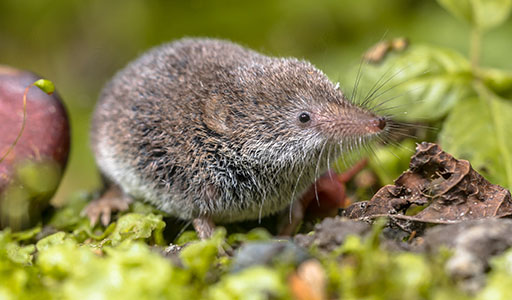Shrews

Shrew Information
Shrews are small rodents with pointed snouts and long, hairless tails. Shrews’ diet consists of small insects, nuts, and vegetation. When shrews are in danger of being eaten, they secrete foul-smelling odors from their glands, likely scaring away any potential predators. Some shrews are nocturnal and some hibernate during the winter months, depending on their environment.

What does a Shrew look like?
While they share characteristics with mice, such as size, shrews are distinctive animals. They have elongated snouts, long and narrow skulls, small eyes, sparsely haired tails, and five clawed toes on each of their feet. They are typically uniform in color and their velvety soft fur often appears darker in the winter. Common colorations include brown, black, and gray. The average adult shrew grows about 5 inches (120 mm) long, and males are slightly larger than females.

What does a Shrew eat?
Insects make up a huge portion of shrew diets. They regularly feast on beetles, butterfly and moth larvae, wasps, crickets, grasshoppers, spiders, snails, earthworms, slugs, centipedes, and millipedes. Some species, like the northern short-tailed shrew, produce venom that allows them to immobilize and eat larger prey like frogs, snakes, mice, birds, and salamanders. Finally, select types of shrews forage for seeds, roots, and vegetable matter.

Shrew habitats
Abundantly distributed creatures, shrews are found in a variety of habits in Canada, the United States, and Mexico. Favorite nesting locations include brushy woodlands, bogs, marshes, cultivated fields, flower and vegetable gardens, meadows, and along river banks. Though nesting habits do differ slightly from species to species, many shrews prefer to construct tunnels or inhabit those left over by moles and voles.
Frequently Asked Questions
Many homeowners struggle to tell if tiny animals digging around in the yard are shrews or moles. Although these two types of rodents are alike, there a few differences between them.
Shews have a number of traits that set them apart from moles, such as:
- Short, three-inch-long bodies that weigh as little as a tenth of an ounce
- Small but visible eyes and ears
- Tiny, hairless front feet
Moles, on the other hand, have different physical characteristics, including:
- Larger bodies averaging seven inches in length and weighing about four ounces
- Tiny ears and eyes completely hidden by fur
- Wide front feet with webbed toes used for burrowing
Because these animals spend much of the day underground, using visual cues may be difficult. To determine if a pest is a shrew or mole, study the environment as well.
A bad odor usually indicates a shrew infestation, as the rodents use their musky scent to deter predators. If mounds of dirt pepper the lawn, moles are the likely culprit.


